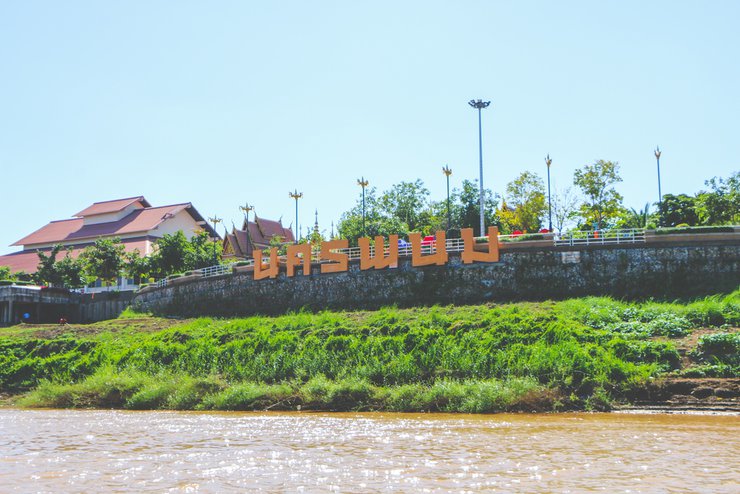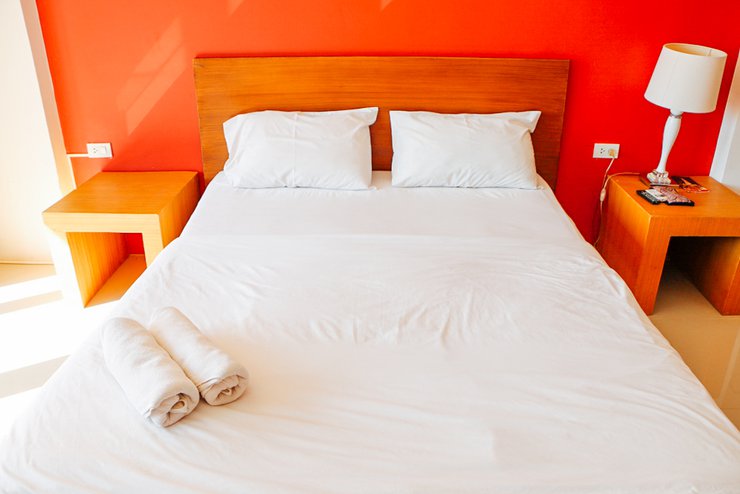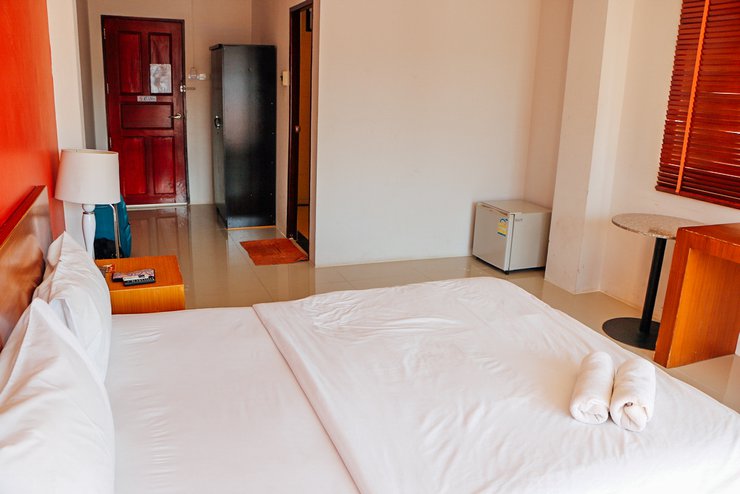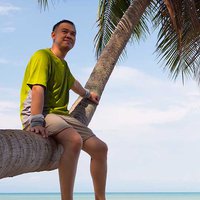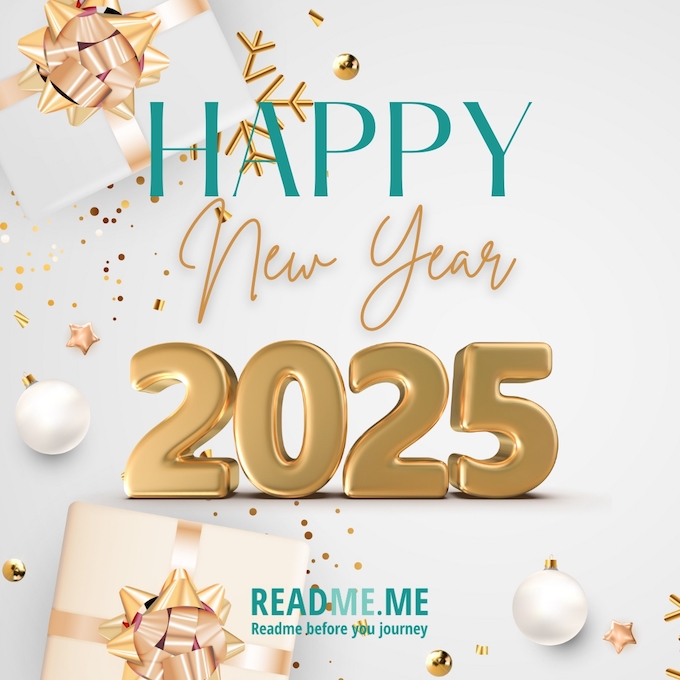
Previously...
I recall seeing the intricate limestone mountain ranges stretching alongside the Mekong River view from the banks of Nakhon Phanom province in the 72 Hours program hosted by Ray MacDonald. The beauty and charm of those mountains seemed to have a magnetic pull, drawing me to explore and experience the atmosphere of the land hidden between the mountain ranges and the Mekong River. I told myself, "One day, I will have to cross over and visit this city."
We had the opportunity to travel to Nakhon Phanom Province for work for a period of 5 days. According to the original schedule, we were supposed to travel to work on Monday morning and return on Saturday. However, we chose to travel 2 days in advance in order to explore Thakhek and Nakhon Phanom. Due to the limited time available, we chose to stay in Thakhek for only 1 day and 1 night, and then returned to continue our trip in Nakhon Phanom.
Review of Tha Khaek: https://th.readme.me/p/7233
The Ferry to Happiness: Exploring Nakhorn Phanom's Joyful Spirit
The ferry glides gently from the bustling port of Thakhek, Laos, towards the serene shores of Nakhorn Phanom, Thailand. This province, nestled amidst the Mekong River's fertile plains, is renowned for its eight sacred and stunning "Phra That" temples. But Nakhorn Phanom's true treasure lies in its people, consistently ranked as the happiest in the nation (National Statistical Office and Department of Mental Health, 2013). This remarkable distinction has earned the province its cherished slogan: "Happiest at Nakhorn Phanom."
What defines this pervasive happiness? What are its roots? Today, we embark on a journey to uncover the secrets of Nakhorn Phanom's joyful spirit.

Before crossing over to visit Thakhek, Laos, we left our luggage containing our work clothes at The P Hometel, our accommodation for the night.

The hotel's location is close to the ferry pier, walking street, Indochina market, and the landmark of the Naga emerging from the water. All of these places are within walking distance, making it very convenient.

The room we reserved is located on the 3rd floor and features a single bed. Amenities include a TV, air conditioning, a refrigerator, and free Wi-Fi.

The price is 580 baht per night without breakfast. However, there are many restaurants near the hotel, so you don't have to worry about going hungry.

The room has an en-suite bathroom, which is relatively spacious and equipped with a water heater.

Although the hotel itself is not located directly on the riverbank, it offers stunning elevated views of the river from its rooftop terrace, perfect for a relaxing moment. However, due to the current hot weather, we will postpone our visit to the rooftop until the morning.

After packing our belongings and completing personal errands, we borrowed bicycles from our accommodation to cycle to Uncle Ho's house in Na Chok Village, also known as the Thai-Vietnamese Friendship Village, located approximately 5.5 kilometers away. The cycling journey took around 30 minutes, and it was a hot afternoon with the sun blazing. We cycled against the sun, almost getting sunburned. Before reaching Uncle Ho's house, there were two hills. It was extremely tiring to cycle uphill, but the downhill ride was comfortable with a cool breeze blowing against our faces.

Uncle Ho's house has two locations: the original house and a replica house built later, which is now a museum. The replica house is located closer to the road than the original house, but they are not far apart. Visitors who wish to see the original house can follow the signs that say "Original House".

Through the entrance archway, one can see the single-story wooden house nestled amidst a variety of trees, creating a tranquil and shady atmosphere.

Ho Chi Minh, the former President of the Socialist Republic of Vietnam, sought refuge under the protection of His Majesty the King of Thailand to regain Vietnam's independence during the war between 1924 and 1931.

This residence served as a central hub for communication, planning, and mobilization efforts in the struggle for national liberation over a seven-year period. Its significance in Vietnam's fight for independence is undeniable, as it played a crucial role in the success of the national liberation movement.

The interior of the house showcases a collection of remaining traditional artifacts and historical photographs that narrate captivating historical tales.

A miniature replica of the statue is placed on the altar for visitors to pay their respects.

The highlight of the exhibit is Ho Chi Minh's original desk, where he strategized the liberation of Vietnam from French colonial rule.



Mr. Sumeth, a Thai-Vietnamese, is the caretaker of this house. He welcomes tourists and tells them about the history of the house through the photographs hanging on the walls.

Growing up in this area, Uncle has witnessed and learned countless stories passed down through generations. Beyond the knowledge he imparts, what truly impresses us is his dedication to sharing these stories. We have no idea how many times he has repeated these tales, but it must be well over 1,000. Every time a new visitor arrives, Uncle eagerly recounts the stories with unwavering enthusiasm.

The side of the house features a traditional rice barn and rice pounding equipment.

A small house with multiple entry and exit points serves as a habitat for carrier pigeons.

The back of the house is the kitchen.

Display of kitchen utensils and agricultural equipment

This modest house may not be grand in size, but it holds a vast collection of memories and stories that are significant to Vietnamese history. Open daily from 6:00 AM to 6:00 PM, the house is free to visit, but donations are welcome to support its upkeep.

From Uncle Ho Chi Minh's house, we cycled back into town to visit the Nakhon Phanom Governor's Residence Museum (Old Building), which is located on the banks of the Mekong River and only 1.6 kilometers from our accommodation or the clock tower.

The Old Governor's Residence of Nakhon Phanom Province was originally the private property of Phraya Adulyadetcha Siammesawarapakdipiriyaphaha (Ui Nakornthap), the first governor of Nakhon Phanom Province and the governor of Udon Thani Province. It was built between 1912 and 1914 by Vietnamese builders. The upper and lower floors have no pillars and use wooden dowels, so there is not a single nail used in its construction.

Subsequently, Phraya Adulyadet sold this building to the Ministry of Interior to be used as the residence of the Governor in 1927.

The museum showcases a photographic exhibition titled "Once Upon a Time...Nakhon Phanom," which narrates the city's history. The exhibition spans two floors and is divided into ten zones, including the "Hall of Honor," which commemorates the city's past governors.

The "Old Tales in Pictures" zone showcases photographs that tell stories about Nakhon Phanom, including both the history and memories of the city.


The highlight of the museum is the Royal Residence Zone, which showcases the room where King Bhumibol Adulyadej and Queen Sirikit stayed during their visit to Nakhon Phanom on November 12, 1955.



Behind the museum building, there is an exhibition hall displaying "Heua Fai" or fireboats.

The exhibition showcases miniature replicas of illuminated boats, accompanied by historical information and the significance of each vessel.


Open Wednesday - Sunday, 9:00 AM - 5:00 PM. Admission fee: 20 Baht.

After visiting the Governor's Residence Museum around 4:30 PM, the next destination was a scenic boat trip along the Mekong River to watch the sunset.

The banks of the Mekong River in Nakhon Phanom feature a riverside promenade designed for public recreation and scenic enjoyment. The promenade is divided into three sections: a leisure area for relaxation and activities, a walking/jogging path for exercise, and a scenic viewpoint.

The final highlight is the multi-kilometer cycling path, meticulously designed and landscaped, offering stunning scenery and a refreshing atmosphere, especially during mornings and evenings. This idyllic setting makes it an ideal spot for relaxation, leaving one envious of the residents who have the privilege of calling this place home.

Daily sightseeing cruises along the Mekong River are available once a day at 5:00 PM, costing 50 baht per person. It is recommended to arrive 15 minutes early to choose your seats. There are two decks to choose from, with the upper deck offering the best views.

The boat provides water and food, but passengers are also welcome to bring their own food and drinks on board.

The boat slowly sailed out of the pier against the current, heading north at a leisurely pace. It passed by old houses and government buildings, with the onboard staff providing informative commentary and introductions to the sights along the way.

Past the clock tower

A cool breeze constantly brushed against my face, creating a refreshing and pleasant atmosphere.


The boat sailed to the Church of St. Anne and then turned back the same way, but sailed parallel to the Laotian side.

The riverbank in Laos is eroding, causing large trees to fall into the water. The narrator on the boat explains that there used to be two large trees growing together, but now only one remains. Its partner has been washed away by the Mekong River. It is a sad sight.

On the way back, the staff started walking out to greet passengers and collect ticket fares.

The sun is slowly setting on the horizon of Thailand, as seen from the banks of Laos.

The sky was exceptionally clear that day, devoid of even a single cloud. The cold wind had swept them away to Bangkok, leaving the final rays of sunlight to diffuse across the heavens. The colors shifted gently, creating an unfamiliar and breathtaking spectacle.

The ship slowly turned around and headed towards the pier.

As dusk settles, the lights from buildings, homes, and temples illuminate the surroundings.

The last rays of sunlight at the edge of the horizon helped to make the background of the temples and monasteries located along the banks of the Mekong River look even more magnificent.


The boat slowly sailed past the landmark of the seven-headed serpent emerging from the water.




The hour-long scenic cruise along the Mekong River was an unforgettable experience, offering breathtaking views and a sense of tranquility. This activity is highly recommended for anyone visiting Nakhon Phanom province.

After the boat trip, we went for a walk to find something to eat at the walking street, which is open every Friday-Sunday evening.

A quick bite of hot rice toast.

Insects and lie plump.


The popularity of this barbecue restaurant can be gauged by the length of the queue.

This one waits in line for a share from those who have finished buying, with an extremely pitiful expression.

The walking street begins at the ferry pier, passes the clock tower, and continues for about 200 meters to the end point, for a total of about 300 meters, parallel to the Mekong River.

Aunt's coconut pancakes are delicious, freshly made and hot in every pan.

Passing by a chill-out spot called H-Clock.

Stir-fried ice cream? I'll pass in this cold weather.

Passing through the city square, where there are small photo corners to capture memories.


The atmosphere is lively, the food is delicious, and the weather is cool and comfortable. It feels good to the heart.

After strolling around and satisfying our hunger, we returned to the hotel for a shower before venturing out again late at night. Initially, we planned to relax at the H-Clock cafe, but it was crowded and there were no seats available. So, we opted for the Chiwka View Cafe, a riverside cafe with stunning views of the Mekong River.

At that time, there were only two customers left. I came alone, so I chose a seat at the bar. After sitting for a while, the staff brought a large teddy bear to sit with me, fearing that I would be lonely. I stayed until the shop closed and then went back to sleep.

The next morning, which was our first day of work, we still had some time in the morning while waiting for our colleagues to travel from Bangkok. So we decided to wake up to watch the sunrise on the hotel rooftop and experience the morning life of the people.

The rooftop of the hotel offers stunning 360-degree views and a delightful atmosphere.

The eastern front view is the Mekong River, with the mountain range of Thakhek, Lao PDR, in the background, stretching parallel to the river.




The rear and side views are of houses.




The sun slowly rises from the land of Laos.

The first burst of light painted the surrounding atmosphere in shades of orange.



Let's take a walk along the Mekong River to observe the morning life of the locals. Follow me!


The bicycle landmark is located behind the accommodation. If we had a house here, we would come here to cycle every morning and evening.

Across the bridge of the twin serpent kings


To a nearby riverside park.

Elderly people, including uncles, aunts, grandfathers, and grandmothers, come here to exercise and breathe fresh air.




We walked until we stopped to watch a large group of girls having fun dancing and swaying.

Some songs are performed solo.


Some songs require dancing in pairs. When choosing partners, there was some playful competition, which was very cute.



We sat and watched for a long time, feeling a sense of shared joy with everyone there, even though we weren't dancing ourselves. This made us realize that happiness can be contagious and spread to others.

During the break, everyone recharged with a banana each, and they even offered me an extra one. In fact, they offered me several, but I only accepted one. The aunties were all so kind and generous.

We walked back to our accommodation to borrow bicycles to cycle to the Basilica of Saint Anne or Wat Nong Saeng.

The Anna Shrine is located on the banks of the Mekong River, approximately 2.5 kilometers north of our accommodation. The bike ride along the riverside cycle path was incredibly relaxing.


At the back of the entrance archway, a life-size statue of Saint Anne stands in the open space in front of the cathedral.



Flanking the cathedral are two striking yellow colonial-style buildings, though their interiors remain empty and unused.


From Wat Phra That Na Pon, cycle back into the city center, following Aphiban Bancha Road, which runs parallel to the riverside road, for approximately 1.7 kilometers. You will reach the National Library of Thailand, dedicated to Her Majesty Queen Sirikit.

Originally the city hall of Nakhon Phanom province, it was built using the blueprint of Chiang Rai's city hall as a prototype. The building is in the Renaissance style and was constructed in 1915 during the reign of King Chulalongkorn (Rama V).

This library serves as a repository for the nation's intellectual heritage, housing books, printed materials, audiovisual resources, ancient language texts, manuscripts, inscriptions, palm-leaf manuscripts, and rare books produced in the region. It is open to the public from Tuesday to Saturday, 9:00 AM to 5:00 PM.

Due to our limited time, we only had time to take photos at the front before cycling back to our accommodation. We stopped to take a few more photos along the way.

The horse is missing. Whoever took it, please return it immediately.


The sun is out, but it's not hot because the air is cool. This is perfect for photosynthesis and getting vitamin D.


I was born during the reign of King Bhumibol Adulyadej (Rama IX).

The area around the clock tower roundabout features several preserved old houses.

The Thai Samakki Hotel, an old hotel that is no longer open to the public, has remained in its original state alongside the clock tower for many years.


We cycled back to the hotel to shower and change. It turned out that I had forgotten to bring a belt to work, so I went out to buy one at the Indochina Market, which was near our accommodation. While I was choosing, an aunt came up to me and greeted me because she remembered that I had gone to watch her dance that morning. The aunt was the owner of the shop where I was choosing a belt, so she gave me a special discount. She was so kind again.

We returned to our room to change, pack our belongings, and check out. We waited for our colleagues to pick us up and take our luggage to the hotel arranged by the company. We continued working until Friday. In the following sections, we will review some of the food we enjoyed and the places we visited during our five-day work trip. Let's begin!

The first restaurant is "Khao Pun Kut Sakoi", located at the Talat Tor Reung night market. This is our favorite restaurant (Kut Sakoi is the name of a village in Nakhon Phanom province).

Freshly made, soft rice noodles with a choice of two flavorful broths: fish sauce and shrimp paste. The special recipe boasts a rich and intense flavor, complemented by perfectly boiled eggs and vegetables. A truly harmonious combination.

This is the first time we've tried it, and we absolutely loved it. The fish sauce in particular was incredibly flavorful. Just thinking about it makes our mouths water.

The second restaurant is "Khao Tom Sen (Vietnamese Kway Chap)" located at the night market, opposite the Khao Pun restaurant.

The restaurant's signature dish is "Khao Tom Sen" or "Vietnamese Kway Chap," as the name suggests. Customers can choose from a variety of toppings, including pork sausage, chicken drumsticks, or offal. The Kway Chap noodles are soft and plentiful. It's a must-try.

The third restaurant, "Pern Pla Pen," is a riverside restaurant located approximately 9 kilometers from the city center on the Friendship Bridge. When I arrived, it was already dark and quite chilly, so I was unable to capture the ambiance. However, during the day, the restaurant boasts stunning views.

The restaurant's signature dishes include grilled fish, either pla poh or pla kang, and lemongrass-fried chicken wings.

The fourth restaurant is "Nong Saeng Boat Noodle Shop", located near the Church of St. Anne in Nong Saeng.

During the day, the restaurant is quite busy. While waiting, customers can enjoy crispy pork rinds dipped in a spicy chili sauce mixed with peanuts, or grilled fresh chilies dipped in shrimp paste. This is a delightful way to pass the time while waiting for your meal.

The highlight of the menu is the "Jumbo" boat noodles with a rich, flavorful broth. The generous portion of noodles and toppings is a steal at only 50 baht.

The fifth restaurant is "On Son Der," a papaya salad restaurant by the Mekong River, located near Wat Klang. Their signature dish is the fermented fish and fresh shrimp papaya salad, which is sure to tantalize your taste buds.

The final stop is "Hor-Na-Lika," a restaurant-pub hybrid. The front faces the walking street near the clock tower roundabout, while the back overlooks the Mekong River.

Customers tend to be quite crowded on Friday, Saturday, and Sunday nights. If you want a table, it is recommended to arrive before 10 pm.

This place has a great atmosphere, the music is beautiful, and it's perfect for chilling out.

After work, the farthest I've traveled is to the 3rd Thai-Lao Friendship Bridge. Other than that, I usually just take a walk along the Mekong River because the weather is very pleasant in the evening.

This spot is located beside the Mekong River bridge. There is a sign that says "Happiest at Nakhon Phanom" where you can take a commemorative photo. It is recommended to arrive here around 5-6 pm, as it will be too dark to see the sign after that time.

From the riverside viewpoint, drive back along the road to the immigration checkpoint to see the lights at the end of the bridge on the Thai side.

Upon arrival at the checkpoint, find a parking spot on the side of the road, ensuring not to obstruct the entrance or exit. Proceed on foot through immigration without any paperwork. However, it is advisable to inform the checkpoint officers of your intention to walk to the bridge's end to enjoy the view.

From this point, you can continue walking to the front of the blue fort.

The best time to admire the illuminated beauty of the bridge's lamps is at midnight. If I recall correctly, the lights are turned off around 10 p.m. every day.

Five working days have passed. Hooray! We only have one day left in Nakhon Phanom before returning to Bangkok. On this last day, we plan to pay respects to the sacred relics of Nakhon Phanom Province, which are a total of 8 relics, scattered in several districts, including:
1. Phra That Phanom, That Phanom District, the principal Buddha image for those born on Sunday.
2. Phra That Renu, Renu Nakhon District, the Phra That for those born on Monday.
3. Phra That Si Khun, Na Kae District, the pagoda for those born on Tuesday.
4. Phra That Mahachai, Pla Pak District, the principal Buddha image for Wednesday.
5. Phra That Muang Khon, That Phanom District, the Phra That for Wednesday (night) birthdays.
6. Phra That Prasit, Na Wa District, the Phra That for those born on Thursday.
7. Phra That Tha Uthen, Tha Uthen District, the Phra That for those born on Friday.
8. Nakhon Si Thammarat Chedi, Mueang District, the chedi for those born on Saturday.
Given the limited time available, it is uncertain how many sacred relics we will be able to visit. Let's find out together.
We departed from our accommodation in Nakhon Phanom city at around 10 am. Driving parallel to the Mekong River along Highway 212 southbound, covering a distance of approximately 52 kilometers, it took us about an hour to reach Wat Phra That Phanom Woramahawihan in That Phanom district. This temple houses the sacred Phra That Phanom, a revered relic of Nakhon Phanom province.

The stupa is a square-shaped brick pagoda, estimated to have been built between 1200 and 1400 CE. According to legend, it was constructed by the 500 Arahants led by the Venerable Maha Kassapa and the rulers of various cities.

The inner chamber enshrines the sternum relic of the Buddha, the presiding relic for those born on Sundays. On the day of our visit, a steady stream of devotees came to pay their respects.

Our first visit to the sacred Phra That Phanom left us with an overwhelming sense of awe and spiritual fulfillment.

The magnificent beauty and grandeur of the temple, combined with the fervent faith of the devotees, create a palpable sense of the sacredness of the relic.


After paying respects at the Phra That, it was lunchtime. We drove around the temple area looking for a place to eat and ended up at "Dao Thong Restaurant," a Vietnamese restaurant located near the Rueng Arun Ratchakarn Gate.

The restaurant offers a wide variety of delicious dishes at affordable prices.

After a hearty meal, the journey continued to Phra That Si Khun in Na Kae District, located approximately 26 kilometers south of Phra That Phanom. The journey took about 30 minutes.

The stupa is not very large. Inside, it enshrines the relics of the Arahants Moggallana, Sariputta, and Sangkaccayana. It is the presiding stupa for those born on Tuesday.

Our stay here was brief, so we continued our journey to the Phra That Renu temple in Renu Nakhon district, located approximately 27 kilometers north of Phra That Si Khun. The journey took about 30 minutes.

The Phra That Renu is located at Wat That Renu and was built in 1918. It is a replica of the original Phra That, which houses the Tripitaka, gold and silver Buddha statues, and other valuables donated by the city's rulers and residents.

The most striking feature of the Phra That is its alternating pink and white color scheme, adorned with gold-painted lotus flower motifs.

The Phra That Renu is the designated pagoda for those born on a Monday.


After visiting the Phra That Renu temple, we continued driving eastward until we reached Highway 212, the same road we had taken along the Mekong River from Nakhon Phanom earlier that morning. We then backtracked for approximately 16 kilometers until we encountered a large tree concealing the Phra That Muruk Khao temple.

The Phra That Murukhanakhon is located at Wat Murukhanakhon in That Phanom District. It is the designated pagoda for people born on Wednesday night.

The stupa resembles the Phra That Phanom stupa in shape and stands approximately 40 meters tall. It was constructed to commemorate the 50th anniversary of the reign of His Majesty King Bhumibol Adulyadej.


After visiting Phra That Mukdahan, we drove back to Nakhon Phanom city to pay respects at Phra That Nakhon, the last temple of the day. The temple is located at Wat Maha That, Mueang District, on the west bank of the Mekong River.

The inner chamber contains relics of an arhat, along with a golden Buddha statue and other valuables donated by devotees.

The Nakhorn Si Thammarat Chedi is the designated pagoda for those born on a Saturday.

In conclusion, on the final day of our journey, we were able to pay respects to five sacred stupas: Phra That Phanom, Phra That Si Khun, Phra That Renu, Phra That Muang Khon, and Phra That Nakhon. These five stupas are conveniently located along the same route and are relatively close to one another. We plan to visit the remaining stupas on our next trip to complete our pilgrimage.

The final view from the banks of the Mekong River, captured in front of Wat Mahathat, remains etched in my memory to this day.

We rushed to Nakhon Phanom Airport to check in for the 5 pm flight.


The sun slowly dipped below the horizon, signaling the end of its journey for the day.

During our eight-day stay in Nakhon Phanom, we witnessed the simple, unhurried, and friendly lifestyle of the locals. The beautiful natural surroundings, coupled with the presence of sacred sites that provide spiritual solace, contribute to the overall sense of happiness among the residents. Even as visitors, we experienced a profound sense of joy during our brief stay. The extent of happiness, however, is subjective and depends on individual perspectives. Nevertheless, our journey to Nakhon Phanom was undoubtedly a blissful experience.
LIFE IS A JOURNEY | Because life is a journey...
Follow our journey at: https://www.facebook.com/LifeIsAJourneyThailand
Data sources: www.tourismthailand.org / https://goo.gl/PpJ0re
Note: If any information is incorrect, please feel free to suggest corrections so that we can make the information as accurate and complete as possible.
LOVE & LIFE IS A JOURNEY
Friday, October 4, 2024 3:18 PM





